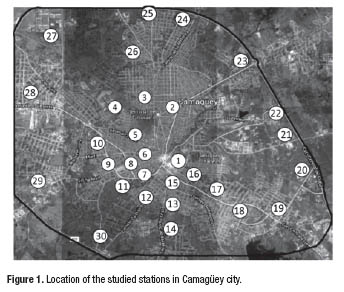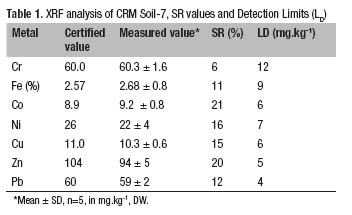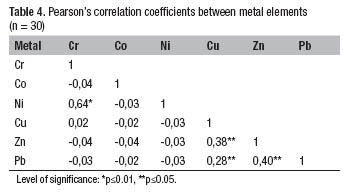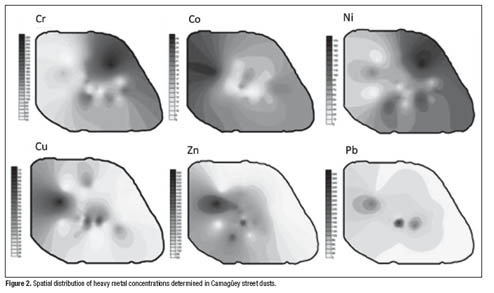Mi SciELO
Servicios Personalizados
Revista
Articulo
Indicadores
-
 Citado por SciELO
Citado por SciELO
Links relacionados
-
 Similares en
SciELO
Similares en
SciELO
Compartir
Nucleus
versión impresa ISSN 0864-084Xversión On-line ISSN 2075-5635
Nucleus no.58 Ciudad de La Habana jul.-dic. 2015
CIENCIAS NUCLEARES
Spatial distribution and contamination assessment of heavy metals in street dust from Camagüey city (Cuba) using X-ray fluorescence
Distribución espacial y estudio de contaminación por metales pesados en polvos urbanos de la ciudad de Camagüey (Cuba) mediante fluorescencia de rayos X
Oscar Díaz Rizo, Oreste Rivero Plama, Katia D'Alessandro Rodríguez, César García Trápaga
Instituto Superior de Tecnologías y Ciencias Aplicadas (InSTEC)
Ave. Salvador Allende y Luaces. La Habana, Cuba
odrizo@instec.cu
ABSTRACT
Concentrations of Cr, Co, Ni, Cu, Zn, Pb and Fe in the street dust from Camagüey city were studied by X-ray .uorescence analysis. The mean Cr, Co, Ni, Cu, Zn and Pb contents in the urban dust samples (97 ± 30, 14 ± 2, 35 ± 36, 94 ± 26, 199 ± 87 and 42 ± 29 mg.kg-1 dry weight, respectively) were compared with mean concentrations in other cities around the world. Spatial distribution maps indicated the same behaviour for Cr–Ni and Pb–Zn–Cu, respectively, whereas the spatial distribution of Co differs from other heavy metals. The metal-to-iron normalization, using Cuban average metal soil contents as background, showed that street dusts from Camagüey city are moderately or significantly Zn-Pb enriched in those areas associated with heavy traffic density and metallurgic plant location. However, the calculation of the potential ecological risk index shows that metal content in Camagüey street dust does not represent any risk for the city population.
Key words: heavy metals; Cuba; X-ray fluorescence analysis; dusts; pollution; health hazards; roads; spatial distribution; concentration ratio
RESUMEN
Se determinan por fluorescencia de rayos X las concentraciones de Cr, Co, Ni, Cu, Zn y Pb en los polvos urbanos de la ciudad de Camagüey. Los contenidos medios de metales pesados en las muestras de polvos urbanos (97 ± 30, 14 ± 2, 35 ± 36, 94 ± 26, 199 ± 87 y 42 ± 29 mg.kg-1 en peso seco respectivamente) son comparados con las concentraciones medias determinadas en otras ciudades del mundo. Los mapas de distribución espacial indican comportamientos similares para Cr–Ni y Pb–Zn–Cu respectivamente, en tanto la distribución espacial de Co difiere del resto de los metales. La normalización a un metal de referencia, empleando como fondo los valores medios de concentraciones de metales pesados cubanos, mostró que los polvos urbanos de la ciudad de Camagüey tienen un enriquecimiento moderado o significativo de Zn y Pb en aquellas áreas que están asociadas a una elevada densidad del tráfico automotor y a la ubicación de plantas metalúrgicas. El cálculo del índice de riesgo ecológico potencial mostró que el contenido de metales pesados en los polvos urbanos de Camagüey no representa riesgo alguno para su población.
Palabras claves: metales pesados; análisis por fluorescencia de rayos X; polvo; polución; riesgos para la salud; carreteras; distribución espacial; tasa de relevancia; Cuba
INTRODUCTION
Street dust usually consists of soil, deposited airborne particles, construction materials and soot or fumes discharged from industries, waste incinerators or vehicles, among others. Its composition is, in essence, a sensitive indicator of urban environmental quality, providing valuable information beyond the single analysis of urban air, water or soil samples [1]. Metals in dust can accumulate in human fatty tissue and internal organs via direct inhalation, ingestion and dermal contact absorption [2-3], causing risk to human health because of their toxicity and non-degradability, especially for children who are more sensitive than adults [4-6]. In Cuba, the assessment of heavy metal content in urban soils and the evaluation of its impact on human health and on urban agriculture started recently [7-14]. However, heavy metal content in urban dust from a Camagüey city has not been reported yet.
Camagüey, a city with a population of 324 989 inhabitants, from which 16.3 % are children [15], is one of the oldest Cuban cities, where some metallurgic plants are located, and, due to their geographical position, an important vehicular maintenance center, which may represent a significant heavy metal emission source into the environment. Furthermore, in 2015 Camagüey celebrated the 500 anniversary of the city foundation. On this special occasion, important restoration works were performed in urban areas in the last few years. Therefore, the main objective of this study was to investigate the contents and spatial distribution of heavy metals in Camagüey street dusts to estimate both their potential risks as well as sources of pollution.
MATERIALS AND METHODS
Thirty street dust samples (each weighting approximately 150 g) were collected from different locations (St.) in the highly urbanized region of Camaguey during the same journey (Fig. 1). Samples were collected close to recreational centers (St. 1, 5, 7, 8, 16), parks (St. 6, 12, 13, 14), schools (St. 17, 21, 22, 25, 26), hospitals (St. 9, 10, 15, 30), factories (St. 4, 11, 20, 24, 29), hotels (St. 3, 19), metallurgical plants (27, 28), residential areas (St. 18, 23) and in the railway station (St. 2). Each sample was collected by gently sweeping an area of about 16 ![]() in the street crossroad using a plastic hand broom and transferred to a clean, self-sealed polyethylene bag. In the laboratory, samples were first dried at 35 °C and large rock, metallic and plastic pieces and organic debris were removed before sieving. The fractions smaller than 2 mm were ground to a fine powder (< 63 µm) in an agate mortar. The pulverized samples were newly dried at 35 °C until obtaining a constant weight. For analysis, samples were mixed with cellulose (analytical quality) in proportion 4:1 and pressed at 15 tons into the pellets of 25 mm diameter and 4–5 mm height.
in the street crossroad using a plastic hand broom and transferred to a clean, self-sealed polyethylene bag. In the laboratory, samples were first dried at 35 °C and large rock, metallic and plastic pieces and organic debris were removed before sieving. The fractions smaller than 2 mm were ground to a fine powder (< 63 µm) in an agate mortar. The pulverized samples were newly dried at 35 °C until obtaining a constant weight. For analysis, samples were mixed with cellulose (analytical quality) in proportion 4:1 and pressed at 15 tons into the pellets of 25 mm diameter and 4–5 mm height.
The Cr, Co, Ni, Cu, Zn and Pb concentrations were estimated by X-Ray Fluorescence Analysis (XRF) using the experimental array and methodology described in [7, 10]. The spatial distribution maps of all studied heavy metals in urban street dust from Camagüey city were generated with ArcGIS software.
The accuracy was evaluated using the SR criterion, proposed by McFarrell [16]:
where ![]() experimental value,
experimental value, ![]() certified value and s is the standard deviation of
certified value and s is the standard deviation of ![]() . On the basis of this criterion the similarity between the certified value and the analytical data obtained by proposed methods is divided into three categories: SR ≤ 25 % = excellent; 25 < SR≤ 50 % = acceptable, SR > 50 % = unacceptable. The analysis of five replica of the CRM IAEA Soil-7 is presented in table 1. All metals (Cr, Fe, Co, Ni, Cu, Zn and Pb) determined by XRF are gexcellenth (SR . 25 %) and the obtained results shows a very good correlation (R = 0.999) between certified and measured values.
. On the basis of this criterion the similarity between the certified value and the analytical data obtained by proposed methods is divided into three categories: SR ≤ 25 % = excellent; 25 < SR≤ 50 % = acceptable, SR > 50 % = unacceptable. The analysis of five replica of the CRM IAEA Soil-7 is presented in table 1. All metals (Cr, Fe, Co, Ni, Cu, Zn and Pb) determined by XRF are gexcellenth (SR . 25 %) and the obtained results shows a very good correlation (R = 0.999) between certified and measured values.
To assess the possible metal pollution in urban dust, the element enrichment was estimated by normalizing the results to a reference element, using the Enrichment Factor (EF) calculated as: EF = ![]() /
/![]() , where
, where ![]() is the ratio of the concentration of a studied element to the concentration of iron in the sample and
is the ratio of the concentration of a studied element to the concentration of iron in the sample and ![]() is the same ratio but with a background soil [17]. Due to the absence of previous baseline or background studies, the average heavy metal content reported for Cu ban soils [18] were used as background values (BV). Six contamination categories are recognized on the basis of the enrichment factor: EF < 1 corresponds to non-enrichment, EF = 1.2 states deficiency to minimal enrichment, EF = 2.5 moderate enrichment, EF = 5.20 significant enrichment, EF = 20.40 very high enrichment and EF > 40 extremely high enrichment [19, 20].
is the same ratio but with a background soil [17]. Due to the absence of previous baseline or background studies, the average heavy metal content reported for Cu ban soils [18] were used as background values (BV). Six contamination categories are recognized on the basis of the enrichment factor: EF < 1 corresponds to non-enrichment, EF = 1.2 states deficiency to minimal enrichment, EF = 2.5 moderate enrichment, EF = 5.20 significant enrichment, EF = 20.40 very high enrichment and EF > 40 extremely high enrichment [19, 20].
Potential ecological risk index (RI) originally introduced by Hakanson [21] is also calculated to assess the degree of heavy metal pollution in street dust, using the following equations:
where, RI is the sum of the all give risk factors for heavy metals, Ei is the monomial potential ecological risk factor, Ti is the metal toxic factor and the values for each element are in the order of Zn = 1 < Cr = 2 < Cu = Co = Ni = Pb = 5. fi is the metal pollution factor, Ci is the concentration of metals in the street dust, and Bi is a reference value for metals. Different RI classifications of metal pollution are low ecological risk (RI . 150), moderated ecological risk (150 . RI < 300), considerable ecological risk (300 . RI < 600) and high ecological risk (RI . 600) [21].
RESULTS AND DISCUSSION
Concentrations of Cr, Fe, Co, Ni, Cu, Zn and Pb in the street dusts of Camaguey city, together with soil background values (BV), are presented in table 2. The concentration ranges of Cr, Co, Ni, Cu, Zn and Pb were 41.278, 8.26, 7.168, 25.72, 84.553 and 16.401 ![]() , with mean values of 126, 15, 66, 36, 222 and 63
, with mean values of 126, 15, 66, 36, 222 and 63 ![]() respectively. Mean concentrations of the heavy metals in urban soils decreased following this order: Zn>Cr>Ni>Pb>Cu>Co; they were all comparable to the background values with the exception of Zn and Pb, the mean contents of which were 2.5 and 1.8 fold higher than its corresponding background values, respectively. The concentrations of Cr, Ni, Zn and Pb varied greatly, while Co and Cu concentrations were quite homogeneous across the city. The comparison with metal contents reported for other similar population cities worldwide (table 3) shows that those from Camagüey streets dusts results are within the same range.
respectively. Mean concentrations of the heavy metals in urban soils decreased following this order: Zn>Cr>Ni>Pb>Cu>Co; they were all comparable to the background values with the exception of Zn and Pb, the mean contents of which were 2.5 and 1.8 fold higher than its corresponding background values, respectively. The concentrations of Cr, Ni, Zn and Pb varied greatly, while Co and Cu concentrations were quite homogeneous across the city. The comparison with metal contents reported for other similar population cities worldwide (table 3) shows that those from Camagüey streets dusts results are within the same range.
Table 4 depicts the correlation coefficient matrix, listing the Pearson’s correlation coefficient. A very significant correlation (p < 0.01) was found between Cr and Ni (r = 0.64), while significant correlation (p < 0.05) was also found between Cu and Zn (r = 0.38), Cu and Pb (r = 0.28) and Zn and-Pb (r = 0.40). The high correlations between dust metals may reflect that these heavy metals had similar sources.
The spatial distributions of Cr, Co, Ni, Cu, Pb and Zn in the street dusts of Camagüey city are represented in Fig. 2. It is evident that the Cr–Ni and Pb–Zn-Cu spatial distribution characteristics are similar, while Co distribution is unique. That fact is in line with the determined Pearson’s factors.
Two Pb-Zn-Cu hot-spots are located in the centre of city and in the western area. As it is well known, lead, copper and zinc have been identified as typical ‘‘urban’’ metals for which the usual sources are traffic (i.e. vehicular emissions) and other industrial sources such as metallurgical industries and thermo-electric plants [30]. Despite the wide use of lead-free fuels since 2000 in Cuba, Pb is not liable to transfer, resulting in its accumulation in urban soil due to pollution from previous decades [31]. Taking into account that urban soil is one of the main street dust components [1], the hot-spot area of Pb, Zn and Cu located in the centre of the city (highest traffic zone of the city) must be mainly associated with heavy traffic density. The second Pb-Zn-Cu hot-spot area is shown in the metallurgical plant location (station 28) and must be associated with plant emissions.
Furthermore, metal enrichment in street dusts (Fig.3) using the enrichment factors (EF), shows that Camagüey urban dusts are not enriched with Cr, Co and Ni (EF < 1) and only street dusts from a few of the studied stations shows a minimal Cu enrichment (station 16), a moderate Zn-Pb enrichments (stations 7-9, 11-13, 15 and 28) and a significant Zn-Pb enrichment (stations 16-17). The highest Zn-Pb enrichments (7.4 and 6.3, respectively) were determined in station 16. This behaviour is in correspondence with the observed Pb-Zn-Cu hotspot areas (Fig. 2).
To quantify the overall potential ecological risk of determined metals in street dust, RI was estimated as the sum of all calculated risk factors (Fig. 4). RI values in all studied stations are less than 150. Therefore, according to Hakanson classification [21], metal content present in dust from Camagüey city represents a negligible ecological risk to its population. The highest RI value (42.4) was determined in the location of a metallurgic plant (St.28).
CONCLUSIONS
Concentrations of six heavy metals (Cr, Co, Ni, Cu, Zn and Pb) in street dust from Camagüey city were determined by XRF analysis. The metal spatial distribution allowed to identify two Pb-Zn-Cu hot-spots areas, associated with the highest traffic zone of the city and with a metallurgic plant location, respectively. Independently of the moderate or significant Zn-Pb enrichment in the mentioned areas, the metal content in Camagüey street dusts does not represent a risk for the health of the city population.
REFERENCES
[1] PANDEY B, AGRAWAL M & SINGH S. Coal mining activities change plant community structure due to air pollution and soil degradation. Ecotoxicology. 2014; 23(8): 1474-1483.
[2] KURT-KARAKUS PB. Determination of heavy metals in indoor dust from Istanbul, Turkey: estimation of the health risk. Environ Int. 2012; 50(1): 47-55.
[3] LIU E, YAN T, BIRCH G & ZHU Y. Pollution and health risk of potentially toxic metals in urban road dust in Nanjing, a mega-city of China. Sci Total Environ. 2014; 476-477: 522-531.
[4] HUANG M, WANGA W, CHAN CY, et. al. Contamination and risk assessment (based on bioaccessibility via ingestion and inhalation) of metal(loid)s in outdoor and indoor particles from urban centers of Guangzhou, China. Sci Total Environ. 2014; 479-480: 117-124.
[5] ORDONEZ A, ALVAREZ R, DE MIGUEL EC, et. al. Spatial and temporal variations of trace element distribution in soils and street dust of an industrial town in NW Spain: 15 years of study. Sci Total Environ. 2015; 524-525: 93-103.
[6] CHEN H, LU X, LI LY. Spatial distribution and risk assessment of metals in dust based on samples from nursery and primary schools of Xifan, China. Atmospheric Environ. 2014; 88: 172-182.
[7] DIAZ RIZO O, ECHEVARRIA CASTILLO F, ARADO LOPEZ JO, et. al. Assessment of heavy metal pollution in urban soils of Havana city, Cuba. Bull Environ Contam Toxicol. 2011; 87(4): 414-419. doi:10.1007/s00128-011-0378 -9.
[8] DIAZ RIZO O, COTO HERNANDEZ I, ARADO LOPEZ JO, et. al. Chromium, Cobalt and Nickel content in urban soils from Moa, northeastern Cuba. Bull Environ Contam Toxicol. 2011; 86(2): 189-193. doi:10.1007/s00128-010-0173-z.
[9] DIAZ RIZO O, HERNANDEZ MERLO M, ECHEVARRIA CASTILLO F, et. al. Assessment of metal pollution in soils from a former Havana (Cuba) solid waste open dump. Bull Environ Contam Toxicol. 2012; 88(2): 182-186. doi:10.1007/s00128-011-0505-7.
[10] DIAZ RIZO O, FONTICIELLA MORELL D, ARADO LOPEZ JO, et. al. Spatial distribution and contamination assessment of heavy metals in urban topsoils from Las Tunas city, Cuba. Bull Environ Contam Toxicol. 2013; 91(1): 29-35.
[11] GARCIA CESPEDES D, SANTANA ROMERO JL, OLIVARES RIEUMONT S, et. al. Evaluacion de la incorporacion de metales pesados al agroecosistema. Rol de las practicas productivas ejecutadas por los trabajadores agricolas. Rev Cub Salud y Trabajo. 2012; 13(1): 3-9.
[12] GARCIA CESPEDES D, OLIVARES RIEUMONT S, SANTANA ROMERO JL, et. al. Evaluacion de riesgos a la salud por exposicion a metales pesados en cercanias de sitios potencialmente peligrosos con actividad agricola. Rev Cub Salud y Trabajo. 2012; 13(1): 10-18.
[13] DIAZ RIZO O, QUINTANA MIRANDA E, ALONSO HERNANDEZ CM, et al. Niveles de radionuclidos naturales y metales pesados en suelos urbanos de la ciudad de Cienfuegos, Cuba. Nucleus. 2013; (54): 17-22.
[14] DIAZ RIZO O, LIMA CAZORLA L, GARCIA CESPEDES D, et al. Assessment of heavy metal content in urban agricultural soils from the surrounding of steel-smelter plant using X-ray fluorescence. Nucleus. 2015; (54): 38-43.
[15] Cuban National Statistical Office. Cuban population at December 31, 2013 (in Spanish) [on-line]. Available in: http://www.one.cu/Estadistica Poblacion/. [accessed: October 22, 2015].
[16] QUEVAUVILLER PH, MARRIER E. Quality assurance and quality control for environmental monitoring. Weinheim: VCH, 1995.
[17] BIRCH G. A scheme for assessing human impacts on coastal aquatic environment using sediments. In: Coastal GIS 2003: an integrated approach to Australian coastal issues. Wollongong, Australia: Centre for Maritime Policy, University of Wollongong, 2003. Series: Wollongong papers on maritime policy. No. 14.
[18] RODRIGUEZ ALFARO M, MONTERO A, MUNIZ UGARTE O, et. al. Background concentrations and reference values for heavy metals in soils of Cuba. Environ Monit Assess. 2015; 187(1): 4198- 2015.
[19] YONGMING H, PEIXUAN D, JUNJI C, et. al. Multivariate analysis of heavy metal contamination in urban dusts of Xifan, Central China. Sci Total Environ. 2006; 355(1-3): 176-186.
[20] BIRCH GF, OLMOS MA. Sediment-bound heavy metals as indicators of human influence and biological risk in coastal water bodies. ICES J Mar Sci. 2008; 65(8): 1407-1413.
[21] HAKANSON L. An ecological risk index for aquatic pollution control. A sedimentological approach. Water Res. 1980; 14(8): 975- 1001.
[22] SOLTANI N, KESHAVARZI B, MOORE F, et. al. Ecological and human health hazards of heavy metals and polycyclic aromatic hydrocarbons (PAHs) in road dust of Isfahan metropolis, Iran. Sci Total Environ. 2015; 505:712-723.
[23] CHEN H, LU X, LI LY, et. al. Metal contamination in campus dust of Xifan, China: A study based on multivariate statistics and spatial distribution. Sci Total Environ. 2014; 484: 27-35.
[24] RASMUSSEN PE, SUBRAMANIAN SK, JESSIMAN BJ. A multielement profile of house dust in re lation to exterior dust and soils in the city of Ottawa, Canada. Sci Total Environ. 2001; 267(1-3): 125-140.
[25] AL-MOMANI IF. Assessment of trace metal distribution and contamination in surface soils of Amman, Jordan. Jordan Journal of Chemistry. 2009; 4(1): 77-87.
[26] CHRISTOFORIDIS A, STAMATIS N. Heavy metal contamination in street dust and roadside soil along the major national road in Kavalafs region, Greece. Geoderma. 2009; 151(3-4): 257-263.
[27] TOKALIO.LU ., KARTAL .. Multivariate analysis of the data and speciation of heavy metals in street dust samples from the Organized Industrial District in Kayseri (Turkey). Atmospheric Environ. 2006; 40(16): 2797-2805.
[28] CHARLESWORTH S, EVERETT M, MCCARTHY R, et. al. A comparative study of heavy metal concentration and distribution in deposited street dusts in a large and a small urban area: Birmingham and Coventry, West Midlands, UK. Environ Int. 2003; 29(5): 563-573.
[29] McALISTER JJ, SMITH BJ, BAPTISTA NETO J, et. al. Geochemical distribution and bioavailability of heavy metals and oxalate in street sediments from Rio de Janeiro, Brazil: a preliminary investigation. Environ Geochem Hlth. 2005; 27(5): 429-441.
[30] BIASIOLI M, GR.MAN H, KRALJ T, et. al. Potentially toxic elements contamination in urban soils: a comparison of three European cities. J Environ Qual. 2007; 36(1): 70-79.
[31] GUO G, WU F, XIE F, et. al. Spatial distribution and pollution assessment of heavy metals in urban soils from southwest China. J Environ Sci. 2012; 24(3): 410-418.
Received: 23th October, 2015
Approved: 27th November, 2015
























